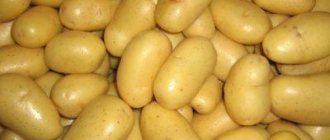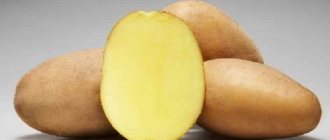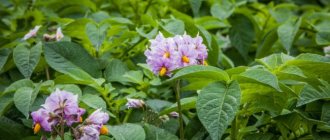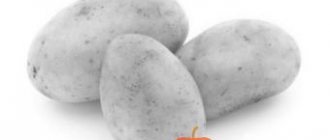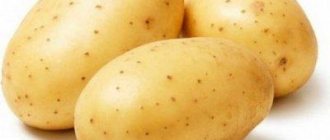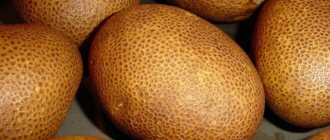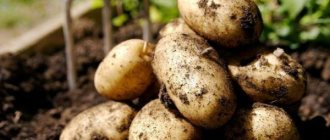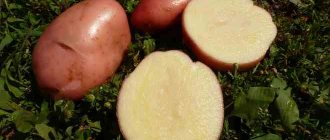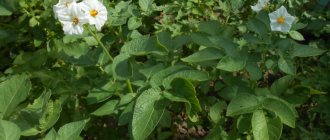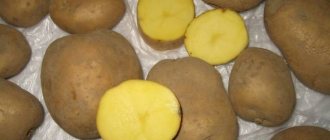Description of the Malinovka variety
Potato Malinovka is a Russian table variety that appeals to many domestic gardeners due to its raspberry-colored skin and white tasty pulp.
Ripening time and yield
Potatoes of the Malinovka variety have an average ripening period. The growing season lasts from 115 to 125 days. The harvest can be harvested already in the last days of August.
If the crop is properly and uncomplicatedly cared for, the variety shows good yield - 35 - 40 tons per hectare. The shelf life of tubers is about 96% under properly created storage conditions.
Potato bushes Malinovka
Disease resistance
Before trying to plant a new variety on your site, it is recommended to understand its immunity. The robin has resistance and low susceptibility to the following diseases:
- viral diseases;
- cancer causative agent;
- golden potato nematode;
- late blight
There is also average resistance to ring rot and rhizoctonia (popular name - black scab).
Late blight of potatoes
Helpful advice! Beds where beets and cabbage previously grew are suitable for planting potatoes. Good harvests are harvested from peat soil after pumpkin.
Appearance Features
The description of the variety should begin with its appearance. The culture is medium-sized, erect, belongs to the stem type and gains a height of up to 0.8 m. The leaves are dark green, large and slightly rough. The inflorescences are purple, simple, medium-sized, multi-flowered.
The tubers are characterized by a round shape. The fruits have a smooth purple-red skin and a small number of eyes. Vegetables have dense, creamy pulp with a starch level of 16-18%. From 8 to 15 tubers are collected from a bush, the weight of one is 80 - 100 grams.
Which regions are suitable for Malinovka
This variety is resistant and is not afraid of low, high temperatures and low humidity, and therefore it is suitable for planting in any region of the Russian Federation. However, the Malinovka potato has proven itself best in the Central and Central Black Earth regions.
Taste qualities
The root vegetable has excellent taste properties. It is used boiled or fried, prepared as a puree and used as a base for potato soup.
When cut or grated, the flesh does not acquire a dark shade. Their small size and thin skin make potatoes easy to process.
Fried potatoes
Dependence of variety selection on climate
Each region of the country has its own climatic characteristics, which have both beneficial and detrimental effects on plants.
The Moscow region does not have the best climate for growing potatoes. Varieties that are resistant to the humidity for which this region is famous are suitable here. This could be Vesna, Zhukovsky early, Timo Khankkiyan (popularly known as simply Timo), Nevsky, Condor, Romano or Lugovskoy. In general, in the Moscow region it is difficult to achieve the desired potato yield, so it is best to plant zoned varieties on the site.
White Spring is an early ripening variety (75-80 days), zoned in the European part of the country and Siberia. Productivity - 320-410 kg per hundred square meters. Disease resistance is average. Due to the short growing season, it is suitable for cultivation in the Arctic. It is possible to obtain two harvests per season. The tubers are light beige, oval, weighing up to 180 grams.
White spring does not require chemical treatment
Timo Hankkiyan is a Finnish variety, unpretentious to the type of soil, with good tolerance to prolonged cold spells, sudden changes in air temperature, excess humidity and drought. It is resistant to viruses and pests. Productivity is from 150 to 300 kg per hundred square meters. The tubers are white, weighing 60–120 grams, tasty, rich in starch, and do not darken during storage.
Timo is distinguished by beautiful white fruits
It should be noted that reviews of Timo among gardeners are extremely mixed. Some people liked it in their gardens, while others claim that its characteristics, including taste, are extremely exaggerated by breeders.
Plant at least three varieties of potatoes on your plot, preferably with different ripening times. This will significantly reduce your likelihood of being left without a harvest. Proper care is key to growing potatoes that are not weeds and will not grow on their own.
The choice of Leningrad gardeners is early and medium varieties. Their first harvest takes place in July.
Nadezhda is an early variety, unsightly for the Colorado potato beetle. Unpretentious to grow. Suitable for central Russia and the Urals. The maximum yield threshold is 416 kg per hundred square meters. Delicious yellow fruits, weighing 90–160 grams.
Nadezhda is resistant to the Colorado potato beetle
Latona is a Dutch unpretentious variety that tolerates both drought and heavy rains. The fruits are yellow, oval-round, weighing 90-140 grams, excellent taste, with a high starch content.
Latona tolerates both high humidity and drought well
Of the mid-late varieties, Eliseevsky, Lena, Volosovsky, Krinitsa, Rosinka grow well here, which are not at all afraid of late blight and the Colorado potato beetle.
The Central Black Earth Region has very good climatic conditions for growing any potatoes.
The most common varieties are:
- early - Vineta, Zhukovsky early, Krepysh, Latona, Neptune, Rosara, Bullfinch, Luck;
- mid-early - Archidea, Zekura, Condor, Crown, Lakomka, Nevsky, Odysseus, Ramos, Sorcerer;
- mid-season - Aspiya, Zhivitsa, Lugovskoy, Olimp, Resurs, Sokolsky;
- late ones - Belorussky 3, Golubizna, Lasunak, Lorch, Naroch, Picasso, Pobeda, Temp.
Siberia and the Urals are areas of risky farming. Not every potato variety can adapt to their climatic conditions. Short summers, frequent cold spells, sudden changes in intense heat with rain and cold nights. Alena, Priekulsky, Udacha, Zhukovsky early, White Spring were able to take root in this climate. Late varieties of potatoes are not planted in the Urals and Siberia.
Popular among the early
Governor is an early ripening variety that is completely undemanding to soil and climate. Productivity - up to 700 kg per hundred square meters. Resistant to most diseases and can be stored for a long time. The fruits are red with white pulp.
Governor—high-yielding variety
Lyubava - yield - up to 400 kg per hundred square meters, unpretentious variety, resistant to cancer pathogens. Affected by golden nematode. Red, round-oval fruits weighing 110-210 grams.
Lyubava is unpretentious in cultivation
Mid-early in the Urals
Among the mid-early varieties, such varieties as Korona, Lukyanovsky, Effect, Aspiya, etc. are popular in the Urals. These varieties have high yields (up to 450 kg) and good resistance to adverse weather conditions.
About the advantages and disadvantages
Each variety has its pros and cons, Malinovka is no exception. If we talk about the advantages, they are as follows:
- stable yield indicators;
- standard size tubers;
- excellent taste;
- the variety is resistant to low humidity and temperature;
- good immunity.
The crop has virtually no disadvantages, but farmers pay attention to the plant’s susceptibility to fungal tuber diseases. This is the characteristic of the Malinovka potato.
Ultra early potato varieties
Also check out these articles
- Gooseberry variety Northern Captain
- The best productive tomato varieties with descriptions and photos
- Orpington chicken breed
- Bee packages and their types
Impala, Bullfinch, Charoite, Ariel, Alena
Ultra-early potatoes are popular in northern regions as they grow quickly. It is also often used if the harvest is going to be sold. However, an early harvest in this case requires the gardener’s full dedication - painstaking care, proper planting and fertilization.
- "Impala" is a variety bred in Holland. The first harvest of potatoes can be carried out 40-45 days after the sprouts appear. It is adapted to many climatic zones and has satisfactory yield (360 c/ha). Potatoes are oval, smooth, pale yellow in color, weighing 130-160 g. Composed of 10-15% starch. Commodity and keeping quality are excellent. There is resistance to potato cancer and viruses.
- “Bullfinch” ripens on the 45th day, and the main harvest begins on the 55th day. Ripens together. The tubers are slightly elongated, the skin is bright pink, and the cut flesh is white. Tuber weight is 60-90 g. 15.7-16% is the amount of starch in the composition. Marketability is good, and keeping quality is excellent. There is immunity to potato cancer.
- "Charoite" ripens very quickly. The first harvest can be harvested after 1.5 months, the main harvest is harvested after about 2 months. The root vegetable is oblong-oval, with a yellowish skin and light yellow pulp, weighing 100-143 g. Starch content up to 17%. Productivity 225-320 c/ha.
- "Ariel" is harvested 1.5 months after the sprouts appear. Thanks to its fast ripening period, it practically does not suffer from anything and is rarely affected by pests. The tubers are yellowish, elongated. The taste is excellent, suitable for boiling and frying.
- "Alena" ripens in 45 days. Potatoes are oval, pink in color with white flesh. The weight of the root crop is approximately 130 g. It contains up to 17% starch. The average yield is 1.5 kg/sq. m. This variety is resistant to many diseases, including fungal diseases.
How to plant and grow
It was already mentioned above that Malinovka is suitable for cultivation throughout Russia. To get a good harvest, you need to pay attention to some nuances.
Preparing for landing
The quantity and quality of the future harvest largely depends on the pre-sowing preparation of planting material. 30 days before the approximate sowing date, you need to start germinating the tubers.
A cool, bright room is suitable for this purpose; the seed here is laid out on the floor. The presence of a warm temperature from +12 to +15 degrees will speed up germination, and then the farmer will spend 15 - 25 days on germination.
If there is not enough space for germination, you can put the tubers in plastic bags, which are pre-equipped with holes to allow oxygen to enter. This technique is called dry germination, and it is completed with a wet stage. After the formation of green shoots, the tubers are placed in boxes, using as a filler: peat with sawdust or a mixture of peat and humus.
Preparing for landing
On a note. Planting material can be laid in layers, but a cushion of fertilizer is made between the tubers.
After the potatoes are laid, you need to water them generously (water at room temperature) to thoroughly moisten all layers.
7 days are allotted for wet germination; all this time you need to ensure that the tubers are in a humid environment. It is recommended to use the following group of fertilizers during the first and last watering:
- ammonium nitrate - 4 grams/liter;
- superphosphate - 6 grams/liter;
- potassium chloride - 4 g/liter.
A liter of solution is used to fertilize 5 kg of potatoes.
Good to know. Before sowing, the tubers need to be sprayed with a weak solution of potassium permanganate to carry out disinfection.
Soil requirements
The land for potatoes is prepared in the previous season. Clay and loamy soils are fertilized with old manure and peat in the amount of 1 bucket. Additionally, add potassium magnesia - 4 tablespoons, as well as ash - 2 cups. After all the fertilizing has been applied, the soil needs to be dug up and leveled so that there are no lumps.
If you have sandy soil, you need to wait until spring to add organic matter, otherwise all useful components will be washed out during the autumn-winter period, and the soil will not have the fertile qualities necessary for potatoes.
How to plant correctly
The easiest way to plant is under a shovel. If necessary, the beds prepared in the fall are leveled and loosened by large lumps of earth. This is done in the spring.
By the beginning of May, if the weather is warm, the soil has already warmed up properly, which means you can start planting potatoes. The prepared area is divided into several rows, between which a distance of 0.7 meters is maintained.
Potatoes are planted in shallow holes (about 10 cm), the tubers are placed so that the sprout is at the top. The planting material is sprinkled with compost, wood ash and only then with soil. A distance of 0.3 meters is maintained between tubers.
Planting tubers
Features of cultivation
Cherry Malinovka
This varietal species is propagated using tubers; as a rule, summer residents plant potatoes from the previous harvest from year to year.
Note! After 5-6 years of this practice, the potatoes for planting must be changed, because from year to year they degenerate, diseases accumulate, and the taste quality decreases significantly. To get rid of these problems and increase productivity, agricultural technicians advise either buying new tubers or germinating them from seeds.
Standard agricultural technology is used for cultivation; due to the timing of germination, it is recommended to germinate seeds half a month before sowing, in early March. They should be soaked for a couple of days and planted in a soil mixture of garden soil and peat in a ratio of 1 to 4, the step between adjacent seeds is 5 cm, and between rows is 10 cm. We must not forget about timely moistening and fertilizing.
Potato seedlings "Malinovka"
Seedlings are planted in open ground when it is heated to at least plus 10 degrees, the holes must be at least 10 cm deep. After 110 days, you can already harvest young potatoes and eat them without even peeling off the thin skin.
By the end of summer, the tops become dark and the peel is rough, and harvesting can begin. The harvested potatoes should be dried for a couple of days in the shade with good ventilation. You can store it in the cellar, putting it in boxes or nets.
Russian summer residents and farmers liked the new variety of table potatoes, named “Malinovka” for its characteristic skin color. It has tasty juicy pulp, does not require special care and produces a good harvest.
How to harvest and store crops
Technical ripeness of Malinovka begins 110 days after sowing. The tubers are covered with thin, almost transparent skin, but they can already be eaten.
At the end of summer, the skin becomes denser and tougher. These potatoes can be stored in the cellar for long-term storage.
Storage Features
Darkened tops lying on the ground indicate a ripe harvest. A pitchfork is used to dig up tubers to avoid severe damage to the roots. The collected potatoes are laid out in a room with good ventilation to dry. This stage lasts 3 - 4 days.
Nets or large boxes are used to store root vegetables. The tubers must be stirred periodically to ensure oxygen access to the lower layers. The temperature in the cellar must be maintained at +2 to +4 °C; a higher value leads to potato germination. Ideal air humidity is 85-90%.
The Malinovka variety shows a shelf life of 96%, yield waste, with proper storage, is only 4%.
Harvesting
The first potatoes can be tasted in mid-August. They dig up the bush and separate the tubers from the tops. On the first harvest, the skin is thin and easy to peel off, and the potatoes themselves have an excellent taste and appetizing aroma. The process of harvesting the entire harvest begins in September. All tubers are dug out of the ground and then placed in several rows to dry in the sun. The main cause of crop rot is moisture getting on the skin. Because of this, the potatoes quickly deteriorate, rot, and the rot quickly spreads and affects neighboring fruits. To avoid the formation of rot, the fruits are well dried in the sun and cleaned of soil. Many gardeners wash the tubers with water after harvesting; the potatoes become beautiful and are convenient to peel later. In this case, be sure to let the tubers dry thoroughly and turn them over in the sun.
When all the fruits are dry, they are distributed into wooden boxes or bags and then stored. Immediately separate those tubers from which they will be planted next year. Potatoes can be stored for a long time, up to 8 months. For storage, use a basement or cellar, where the temperature does not rise above plus 16 degrees. At higher temperatures, the tubers germinate and spoil. A small amount of the vegetable can be stored at home, but not in the refrigerator.
About diseases and pests
Despite good immunity, this variety is affected by fungal diseases, and late blight is considered the main scourge. Most often, the problem occurs in areas with high humidity and in very dense plantings.
Treatment of tubers is considered an excellent method of prevention. For this, copper sulfate and potassium permanganate are used.
Mulching the beds with onion peels will help get rid of the Colorado potato beetle; insects really don’t like it.
Colorado beetle
Farmers should not have much difficulty growing Malinovka. Timely care and attention will allow you to get a good and tasty vegetable harvest.
How to properly care for potatoes?
We recommend reading our other articles
- Dorper sheep breed
- Varieties of cucumbers for greenhouses
- Asiatic lily flower
- Planting spring garlic
People value the Lapot potato variety very highly for its ease of care.
Photos of potato care
Weeding, loosening the soil, and collecting weeds are necessary and important rules of care. They are done as needed.
Watering is carried out abundantly, infrequently, so that the water does not stagnate. Pour water into the rows, not under the bushes! 2-3 weeks before harvesting, watering is completely stopped.
The first hilling is necessary when the sprouts hatch. They need to be completely hilled up so that not even a leaf remains above the ground! The second hilling occurs when the sprouts have grown by 20 cm. Sometimes a third hilling is done - before flowering.
It is recommended to remove flower stalks if possible.
However, caution is important here so as not to spoil the harvest! This procedure is carried out exclusively with gloves and from time to time you need to wet your hand in a solution of potassium permanganate so that when the peduncle is torn off, you can simultaneously disinfect the place where it was torn off. Fertilizing is carried out with organic or mineral fertilizers
You can do without this procedure, but only if Lapot potatoes grow in loose, fertile soil
Fertilizing is carried out with organic or mineral fertilizers. You can do without this procedure, but only if Lapot potatoes grow in loose, fertile soil
To improve the taste, solutions of potassium or wood ash are added under the bushes about 2-3 times per season.
Photo of watering potatoes
Important! If you don’t have time to care for potatoes, weed them, remove weeds or water them frequently, you can mulch the beds and row spaces with straw. It is laid out in a layer of 35-50 cm. Among other things, such mulch will protect potatoes from night frosts if spread in the spring, immediately after planting
This mulch, among other things, will protect potatoes from night frosts if you spread it in the spring, immediately after planting.
Pest and disease control can be preventive (folk remedies) or targeted (chemical, biological drugs) when the disease or pest has already appeared. The Colorado potato beetle is usually collected by hand, because few drugs effectively help against it.
Caring for Malinovka potatoes
Without proper adherence to agricultural cultivation techniques, it will not be possible to harvest a good harvest, and therefore it is worth getting acquainted with some recommendations.
Features of watering
Potatoes need moisture, especially during the period of tuber formation. It occurs from the moment of budding until the tops stop growing.
If a dry period has begun, then it is necessary to irrigate the crop. While the growing season is ongoing, potatoes are watered 2 times every 10 days, then another watering is added. To get the highest possible yield, soil moisture is maintained within 70 - 80%.
Feeding and fertilizing
In order for potatoes to grow well, they need to receive nutrients from the soil, and they get into the ground thanks to the timely application of fertilizers. Many farmers use organic matter - slurry or bird droppings, and they also add superphosphate in small quantities.
On a note. After the plants receive watering with fertilizers, they need to be watered with clean water to wash the leaves if the mixture gets on them.
The first time organic matter is added 14 days after the sprouts appear. Then you need to use fertilizing at an interval of 1 time every 2 weeks.
Hilling and weeding
Loosen the soil in the garden bed after each rainfall. If, after sowing, an earthen crust appears, then it must be broken up. This procedure must be done carefully so as not to affect the tubers located underground.
After the stems grow to 10 cm in height, hilling is carried out; it is best to start working after watering or rain, this will have a beneficial effect on the growth of the vegetable crop.
Important! Along with hilling (which needs to be done 2-3 times per season), weeding is also carried out to remove weeds.
Reviews
Those gardeners who planted potatoes of the Malinovka variety were satisfied with the result. Potatoes grow a lot, they have a high shelf life, are stored for a long time and do not spoil. It is advised, if possible, to grow a crop from tubers; this is an easier method than planting seedlings. It is not recommended to feed the robin, otherwise the tops will gain growth and grow greatly. Potatoes grow well on their own and do not need nutritional supplements.
Before planting, it is recommended to treat the fruits with a weak solution of potassium permanganate. The solution leads to the death of pathogenic microorganisms, so the vegetable will not get sick subsequently and will easily tolerate transplantation into open ground. When growing potatoes from seeds, seedlings are kept at outside temperature for a week before transplanting into the soil, this will improve its immune qualities.
“Robin” is suitable for growing in any area and is rightfully considered an unpretentious variety of potato. The variety grows in any soil, even poor or clayey, and does not require constant sun or careful watering. The excellent taste and neat size of the tubers have made the Malinovka variety one of the most popular for planting today.
Video: Growing potatoes. Details about the main thing
